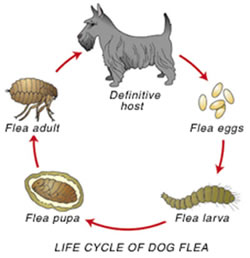My dog’s skin has always been itchy and every summer he has to be treated. Recently, he underwent a lot of tests and I have been told that he has flea allergy dermatitis. The problem is that I have never seen a flea on him. Is this diagnosis correct?
Flea allergy dermatitis (FAD) is the leading cause of itching in dogs. Fleas do not stay on the dog except for when they are feeding. When they feed they inject a small amount of saliva into the skin. Proteins in the saliva are the usual allergen, and cause an intensely pruritic or itchy response. Dogs with FAD don’t have to be infested with fleas to be itchy. In fact, a single flea bite can cause itching for up to a week.
Are only certain dogs allergic to fleas?
FAD can affect any adult dog although some breeds appear to be more prone than others.
How is flea allergy dermatitis diagnosed?
Clinical signs often give the first clue that your pet may suffer from FAD. Itching and hair loss in the region from the middle of the back to the tail base and the rear legs (the ‘flea triangle’) is often associated with FAD. Sophisticated skin and blood tests that will detect a specific flea allergy in your pet are available.
What does treatment involve?
Since it is the injection of flea saliva that causes the allergic response, it is important to prevent fleas from biting your dog. Strict flea control is essential. Even though you have not seen fleas on the dog it is important that you continue rigorous flea treatment and maintain environmental control. Outdoor dogs pose a particular challenge. There is a separate fact sheet that outlines flea control.
What about desensitization? I understand that this is a newer treatment for FAD.
Desensitization or administering ‘allergy injections’ involves injecting increasing doses of a diluted flea antigen over a prolonged period of time. These allergy injections may be continued for life. Desensitization therapy is successful in approximately half of FAD cases. Your veterinarian will discuss the pros and cons of the various treatments for FAD with you during the examination.
What about steroid treatment?
Corticosteroids, ‘cortisone’ or ‘steroids’ are widely used to treat FAD. They often bring about miraculous relief to the poor pruritic patient. However, it should be noted that there are significant potential side effects to steroid use. The long term use of corticosteroids can ultimately result in more harm than good. Steroids can be safely used for short-term relief while flea control is being implemented. Your veterinarian will outline the safest and most effective treatment plan for your pet’s individual needs.

